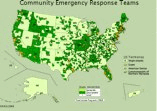Starting a CERT Program
Step 3: Gaining Support & Recruiting
Building CERT Partnerships

For your program to be successful, it will be critical for you to identify potential partners and to form and maintain partnerships.
Identifying the Benefits of Partnerships
In building these partnerships, it is important to determine how the features of the CERT program can benefit the stakeholders and the community. Potential benefits include:
- Better individual and family preparedness,
- Increased neighborhood and workplace involvement with public safety,
- Support of emergency management and its agencies,
- Businesses investment in community safety, or
- The positive perception that the government is reaching out to help the people it serves, etc.
Every member of the community–from private citizens to businesses to government officials–holds a vital stake in preparedness and response. As you build partnerships, you will gain knowledge and a better understanding of the risks affecting your community and the roles that CERT volunteers can play. Even better, you will identify and build resources as you meet knowledgeable and enthusiastic people, gain ideas, and obtain financial assistance.
Identifying Partners and Stakeholders
One of the most important steps you need to take is to identify key stakeholders in your community and recruit individuals, businesses, government officials, service groups, and others to support the CERT program. While every citizen is a potential stakeholder, some will be more willing or able to form partnerships than others.
Take some time to identify potential partners and stakeholders in your community. Some partners, such as homeowner's associations, Neighborhood Watch groups and school groups are "ready-made" partners. The Checklist for Developing Partnerships provides additional partnering suggestions, and you may add other potential partners to the list. After you have identified potential partners and stakeholders, review the questions that follow the checklist. It should get you started on assessing their stake in the CERT program.
Recruiting Partners
Recruiting partners is like assembling a successful team–it takes thoughtful planning. Chances are that you will have only one opportunity to introduce CERT to many potential partners, so you will want your approach to be well thought out. There are ample materials and success stories available about CERT programs, especially if you network with other CERT Program Coordinators.
Emergency preparedness and response is not just an issue for public authorities or first responders. Disasters can occur unexpectedly and overwhelm the response system.
Your stakeholders will come from every segment of the community that can be impacted by a disaster. Recruiting these capable and committed individuals will be key. Let your own enthusiasm and commitment show. It will be contagious!
All partners will want to know how they will benefit from CERT and if the program has elements of success. After all, committing personal time and, perhaps, financial resources requires a full understanding of the importance of CERTs.
Because many of your potential partners will be community leaders who are constantly bombarded with requests for financial and personal support, anticipate the question, "What makes CERT so important?" Be sure to have a response ready, and share some success stories.
Schedule and Prepare for One-on-One Meetings
Schedule individual meetings with the organizations you have targeted for participation. Here's where you will need to give careful thought to your approach. Consider how the organization will benefit from participation. You may need to do some research into the organization to discover motivating factors and leveraging points, such as protection of future profits or safety of employees. For some, a connection with damage prevention may be obvious, and community goodwill is always an important motivating factor.
For neighborhood partners, you will need to learn about any specific hazards faced (is the neighborhood located along a stream that is prone to flooding, for example?) and the makeup of the neighborhood. Try to find a "champion" in the neighborhood who can promote the program to his or her neighbors.
After you have identified the factors you want to stress, develop talking points for one-on-one meetings. Be sure that you develop a clear message on why they should participate, what CERTs can accomplish if supported, and how they can help with the process.
Bringing Partners to the Table
It is important that potential partners realize that beyond the basic training, CERT is a unique program that will be developed based on local needs, and that it is up to the partners to help create the strategy to implement a program that improves community preparedness. You can customize CERT materials to meet the community's specific hazards, demographics, and response needs.
Every community has dynamos in the public and private sector who can lead with powerful effectiveness. The job of recruiting partners will be ongoing, so keep notes of contacts you make and the possible resources they can provide. Also, as you recruit partners, encourage them to identify others who can contribute, personally or financially, to the program.
Developing Win-Win Relationships With Partners
In recruiting partners and forming partnerships, you're looking to build long-term relationships. Anything less will limit the program's effectiveness and increase its operational costs. You should have a clear vision of how your partners can help you in the short- and long-term development of the program.
To benefit your partners as well as your program, take advantage of each partner's normal function in the community. For instance, the media is constantly looking for good stories. The media has the potential to be of critical assistance in promoting the CERT program and community preparedness because:
- The community relies on TV, radio, and the press for news.
- The media has a responsibility for gathering and disseminating critical information to the community.
- Media personnel are part of the community that you are trying to prepare to protect.
Because the media can be a great way to disseminate information about the benefits of CERT, perhaps local stations or newspapers would be willing to broadcast or print program information and announcements. As a result, information about CERT is disseminated more widely and in a more sophisticated way, while the public receives correct information about the program.
Leveraging resources in similar ways with organizations, such as utility companies, hospitals, volunteer organizations, and educational institutions strengthens both the CERT program and the organizations. However, these partnerships involve a high-level, long-term commitment to the program. Your potential partners are investing time, experience, creativity, and money. True partners will embrace CERT and create momentum that inspires and encourages others to participate as well.
Besides financial and personal support for implementing the CERT program, businesses, media, neighborhood organizations, and public safety agencies benefit from the actual CERT program. Their families, loved ones, and employees receive the training that prepares them for hazards, which results in a long-term improvement in public safety.


